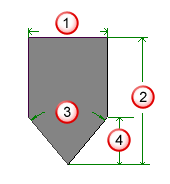Spot Drills are used for spot drilling starter holes.
Center Drills are used to drill starter holes. They are preferred over spot drills for spot drilling operations. Spot Drills can also be used for spot drill operations.
Name — Enter a name that identifies the tool. The name must be unique among all the tools in the crib.
Type — Select Center or Spot.
Measure — This indicates the units that are used for reporting the tool’s dimensions. Select Inches for inch units or deselect it for millimeters.
Diameter — See diagrams.
Body diameter — See diagrams.
Overall length — See diagrams.
Exposed length — This is the amount of the tool that sticks out of the holder if the holder is simulated.
Tip angle — See diagrams.
Size number — Tool size number.
Included angle — See diagrams. This is the angle of the tool portion that does the cutting in a center drill. This option is unavailable if Spot is selected.
Tool material — This indicates what the tool is made of. This information is important when calculating the feeds and speeds.
Tool Finish — This is the coating, or finish, on the tool. This information is also used in feed/speed calculations. If a feed/speed table exists for a material cut with a tool with a Bright finish, but not for TI_N or Black Oxide tool finishes, then the speed values are derived from the Bright table. The speed for TI_N is 1.5 times the BRIGHT speed. The speed for BLACK_OXIDE is 1.05 times the BRIGHT speed. The feed rates are the same as the BRIGHT feed rates.
Hand — Set whether the tool is Right-handed or Left-handed.
Spot drill diagram:
|
|
|
Center drill diagram:
|
|
|

 Diameter
Diameter
 Overall length
Overall length
 Tip angle
Tip angle
 Cutter length
Cutter length

 Included Angle
Included Angle